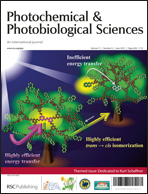Grafting cadmium sulfide onto alumina induces a small bandgap widening and a more significant lifetime variation of the light generated charge carriers from 0.76 microseconds measured for pristine CdS to 0.75, 0.86, and 1.20 microseconds found for CdS/Al2O3 containing 30, 20, and 9% of CdS, respectively. The quasi-Fermi level of electrons of −0.42 V (NHE) is not significantly changed. These alumina grafted semiconductor photocatalysts enable the linear addition of cyclopentene, cyclohexene, and α-pinene to N-adamantylimines affording novel homoallyladamantylamines in isolated yields of 21–85% through a regioselective C–C heterocoupling of intermediate allyl and α-aminobenzyl radicals. As by-products hydrodimers of the imine are formed by C–C homocoupling of the benzylic radicals. Different from heterocoupling, the homocoupling is a stereospecific process directed by the nature of the olefin employed in the reaction.
You have access to this article
 Please wait while we load your content...
Something went wrong. Try again?
Please wait while we load your content...
Something went wrong. Try again?


 Please wait while we load your content...
Please wait while we load your content...